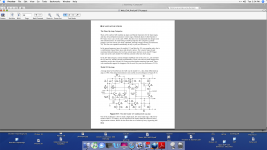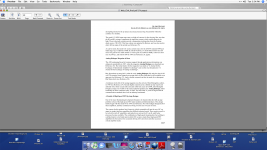OS, if I understand you right: what is the role of a high end DAC if you subsequently feed that analog signal into a lesser component such as a MiniDSP crossover before you send it to the power amps? Wouldn't it be better, one might hypothesize, to feed a digital signal into an electronic crossover with high end DACs, leaving out one ADC-DAC cycle all together?
Well I do wonder that with Richard as he is still using the crown amps on his M2s I believe. Once his mighty amps come over from the marsh factory is another DAC3 on the cards? Or DAC2 on bass DAC3 on mid and high?
Or the Lambo. Both cars are all story and talking thru their hat. They really do not perform better than lesser cars. Not worth the price therefore.

Your amps do ADC-DSP-DAC, don't they Marsh?
yes..... From JBL, I was able to download all the parameters for this spkr model's cross-over via USB directly into the "amp". It is permanently stored there, now. Normally, it would have been shipped preprogrammed but I bought the amps separately .. refurbished from jbl .. and saved a lot of money.
-RM
Last edited:
Well I do wonder that with Richard as he is still using the crown amps on his M2s I believe. Once his mighty amps come over from the marsh factory is another DAC3 on the cards? Or DAC2 on bass DAC3 on mid and high?
I am not sure myself. My first thought is to just take the analog signal off the board as it goes into the digital power amp section and run it thru the new super-duper ultra low distortion all analog amps.
-RM
Last edited:
Actually if you have the recommended I-tech5000 amps then they have AES-EBU in so you could bypass a whole DAC/ADC stage, which 'should' sound even better?
Actually if you have the recommended I-tech5000 amps then they have AES-EBU in so you could bypass a whole DAC/ADC stage, which 'should' sound even better?
yes, that is possible also.
-RM
Last edited:
It looks like there is a big complex PCB in the i-tech amps called a USP3T. It has an analog input with an A/D, a AES-EBU input, and some other digital networking input. What documentation can be found here says the A/D works at either 48kHz or 96kHz. There is something else about everything being SRCed to 48kHz. Then into a SHARC processor, then out through a DAC, and from there into the PWM power amp. Digital signals between data converters and SHARC appear to be I2C.
Anyway, looking at what I could find it doesn't look too promising for using only parts of the processing. Also, can't see any reason to go into it with an analog signal if digital is available since analog gets immediately converted back to digital.
Anyway, looking at what I could find it doesn't look too promising for using only parts of the processing. Also, can't see any reason to go into it with an analog signal if digital is available since analog gets immediately converted back to digital.
I think he was one of the founders of Analog Devices, before IC's became practical.
No, a hired consultant IIRC.
And come on guys we posted the definitive article on forensic sound restoration including identifying and replacing dropouts (by one of Bill's profs) at least twice here.
If there is a desire to replace the i-tech amps, and retain bi-amping, then it would appear that 4 channels of D/A would be required.
If starting over with DSP, my inclination would be to try VST plugins for doing some test processing to see what mix of FIR, IIR, sample delays, etc., measures good and sounds good. Maybe quicker to prototype some potential architectures that way.
If starting over with DSP, my inclination would be to try VST plugins for doing some test processing to see what mix of FIR, IIR, sample delays, etc., measures good and sounds good. Maybe quicker to prototype some potential architectures that way.
No, a hired consultant IIRC.
.
Dick Burwen: The op amps in his home audio system became the foundation for semiconductor manufacturer Analog Devices. He was a founder of Copley Controls Corp, manufacturer of servo amplifiers and switching gradient amplifiers for MRI systems up to 1,000,000 VA.
https://linearaudio.net/authors/365
Jan
Last edited:
The op amps in his home audio system became the foundation for semiconductor manufacturer Analog Devices.
We can let that one pass, a good lesson in how history is created by the participants.
If there is a desire to replace the i-tech amps, and retain bi-amping, then it would appear that 4 channels of D/A would be required.
If starting over with DSP, my inclination would be to try VST plugins for doing some test processing to see what mix of FIR, IIR, sample delays, etc., measures good and sounds good. Maybe quicker to prototype some potential architectures that way.
Simpler yet is to start with an inexpensive laptop with Linux and a USB multichannel sound card. Throw in a low-power multichannel amp to round it out (if one doesn't have a number of amps already laying around). Even if one takes the view that the DAC/electronics are very important, one can then later scale the prototype off to fancier and fancier equipment. Order of magnitude says that monkeying with ms time delays and dB intensity changes are going to matter a lot more than the actual toys you use to slosh those electrons around.
Fascinating that the I-tech5000 is good enough that you can hear the improvement of DAC3 over DAC2 even after another conversion stage. Some good designers they have there at Harman!
Well, I apparently gave a fellow circuit designer more credit that he deserves. I was told by someone, many decades ago that Dick Burwen was closely associated with Analog Devices, so I supposed that he was an early founder. Guess he wasn't, but just a consultant like me.
Here is what he really did for ADI, back in 1966. I respect fellow circuit designers who really show originality and creativity in their work, even if they disagree with me about audio quality trade-offs. Richard Burwen is certainly up there with the best. Equally so, John Iverson. Taking cheap shots at these or other designers, by those who have not done so much, or with such design originality, is revealing.
Here is what he really did for ADI, back in 1966. I respect fellow circuit designers who really show originality and creativity in their work, even if they disagree with me about audio quality trade-offs. Richard Burwen is certainly up there with the best. Equally so, John Iverson. Taking cheap shots at these or other designers, by those who have not done so much, or with such design originality, is revealing.
Attachments
If you read his Bio, he was a prolific designer in many fields Dick Burwen I am sure there are others on here with this depth and breadth of experience, but not many. He does say on there that he consulted to ADI.
Who took a shot at Dick?
Who took a shot at Dick?
I wouldn't call that criticizing him. The Palette as launched was not the design burwen supplied to Cello, plus a system is more than just the tone controls. I never heard a Palette, just twiddled the knobs in a dealers once 🙂.
if you knew Burwen, why would you even ask Otala for the time of day
much less tout Otala as some sort of audio design guru
and the part elided from the 1st quote
is a 2-pole gain structure
in 1966!
much less tout Otala as some sort of audio design guru
One of the techniques is how to make a high speed.. ..degeneration resistors, R8-R9.
The model 121 NPN input stage runs at a high tail current, for fast slewing.
The gain-of-five stable model 121 had a gain of 25,000 (or 88dB), achieved a slew rate of 250V/μs
and the part elided from the 1st quote
..which is by means of the L1-L2 chokes. At low frequencies the chokes shunt the otherwise noisy degeneration resistors..
is a 2-pole gain structure
in 1966!
Last edited:
- Status
- Not open for further replies.
- Home
- Member Areas
- The Lounge
- John Curl's Blowtorch preamplifier part II

